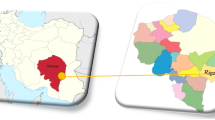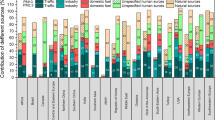Abstract
The objective of this study was to assess the health risk of occupational and public exposures to airborne particulate matter (PM) arising from a subway construction site in Tehran, Iran. The occupational exposure was determined by personal sampling in three occupational groups (drivers, workers, and engineers) and the environmental emission was estimated by sampling from five point exhausts. The PM was measured in terms of total suspended particles (TSP), particles with an aerodynamic diameter of less than 10 μm (PM10), and less than 2.5 μm (PM2.5). The ambient air concentrations of PM were modeled using AERMOD software and the health risk was estimated using AirQ+ software. The average (± standard deviation: SD) concentrations of TSP, PM10, and PM2.5 in the personal sampling were determined to be 3620 ± 250, 1690 ± 260, and 1350 ± 140 μg/m3 for drivers, 2190 ± 200, 1210 ± 310, and 960 ± 190 μg/m3 for workers, 690 ± 70, 410 ± 100, and 320 ± 60 μg/m3 for engineers, respectively. The average PM2.5/PM10 ratio in the workplace and exhausts was as high as 0.79. The average increases in ambient air PM2.5 concentrations in the surrounding areas were predicted to be in the range of 2.4–23.8 μg/m3. The all-cause death rates (per 100,000 persons) attributable to PM2.5 from the construction project for the drivers, workers, engineers, and general people were estimated to be as high as 225, 214.5, 193, and 18, respectively. The results indicated that the health effects of the PM emission in the subway construction site were remarkable; therefore, more control measures for the workplace exposure and environmental emission should be considered.





Similar content being viewed by others

References
Abtahi M, Koolivand A, Dobaradaran S, Yaghmaeian K, Mohseni-Bandpei A, Khaloo SS, Jorfi S, Saeedi R (2017) National and sub-national age-sex specific and cause-specific mortality and disability-adjusted life years (DALYs) attributable to household air pollution from solid cookfuel use (HAP) in Iran, 1990–2013. Environ Res 156:87–96
Adams HS, Nieuwenhuijsen MJ, Colvile RN, McMullen MAS, Khandelwal P (2001) Fine particle (PM2.5) personal exposure levels in transport microenvironments, London, UK. Sci Total Environ 279:29–44
Ahadi S, Roshani M, Naderi M, Torbatian S, Shahbazi H, Hosseini V et al (2016) Tehran annual air quality report in 2015. Tehran Air Quality Control Company, Tehran
Alemayehu D, Hackett F (2015) Gaussian dispersion model to estimate the dispersion of particulate matters (PM2.5) and sulfur dioxide (SO2) concentrations on tribal land, Oklahoma. Am J Environ Sci 11:440–449
Amirkhani Ardeh S, Khaloo SS, Gholamnia R, Abtahi M, Saeedi R (2020) Assessment of indoor air pollutant concentrations and emissions from natural gas cooking burners in residential buildings in Tehran, Iran. Air Quality, Atmosphere & Health 13:409–420
Aneziris O, Papazoglou IA, Kallianiotis D (2010) Occupational risk of tunneling construction. Saf Sci 48:964–972
Arcangeli G, Cupelli V, Montalti M, Pristera M, Baldasseroni A, Giuliano G (2004) Respiratory risks in tunnel construction workers. Int J Immunopathol Pharmacol 17:91–96
Artı́ñano B, Salvador P, Alonso DG, Querol X, Alastuey A (2003) Anthropogenic and natural influence on the PM10 and PM2.5 aerosol in Madrid (Spain). Analysis of high concentration episodes. Environ Pollut 125:453–465
Ashley K, Fey O’Connor P (2017) NIOSH manual of analytical methods (NMAM), 5th edn. National Institute for Occupational Safety and Health, Washington DC
Bakke B, Ulvestad B, Thomassen Y, Woldbæk T, Ellingsen DG (2014) Characterization of occupational exposure to air contaminants in modern tunnelling operations. Ann Occup Hyg 58:818–829
Basagaña X, Triguero-Mas M, Agis D, Pérez N, Reche C, Alastuey A, Querol X (2018) Effect of public transport strikes on air pollution levels in Barcelona (Spain). Sci Total Environ 610-611:1076–1082
Borrego C, Costa A, Tavares R, Lopes M, Valente J, Amorim J et al (2009) Effects of road traffic scenarios on human exposure to air pollution. WIT Trans Ecol Environ 123:89–100
Brunekreef B, Holgate ST (2002) Air pollution and health. Lancet 360:1233–1242
Ezzati M, Lopez AD, Rodgers AA, Murray CJ (2004) Comparative quantification of health risks: global and regional burden of disease attributable to selected major risk factors. World Health Organization, Geneva
Fard RF, Naddafi K, Yunesian M, Nodehi RN, Dehghani MH, Hassanvand MS (2016) The assessment of health impacts and external costs of natural gas-fired power plant of Qom. Environ Sci Pollut Res 23:20922–20936
Fattore E, Paiano V, Borgini A, Tittarelli A, Bertoldi M, Crosignani P, Fanelli R (2011) Human health risk in relation to air quality in two municipalities in an industrialized area of northern Italy. Environ Res 111:1321–1327
Fuller GW, Green D (2004) The impact of local fugitive PM10 from building works and road works on the assessment of the European Union limit value. Atmos Environ 38:4993–5002
Galea KS, Mair C, Alexander C, de Vocht F, van Tongeren M (2016) Occupational exposure to respirable dust, respirable crystalline silica and diesel engine exhaust emissions in the London tunnelling environment. Ann Occup Hyg 60:263–269
Global Burden of Disease Collaborative Network (2018) Global Burden of Disease Study 2017 (GBD 2017) Results. Institute for Health Metrics and Evaluation (IHME), Seattle, United States. Available from: http://ghdx.healthdata.org/gbd-results-tool
Grass DS, Ross JM, Family F, Barbour J, James Simpson H, Coulibaly D, Hernandez J, Chen Y, Slavkovich V, Li Y, Graziano J, Santella RM, Brandt-Rauf P, Chillrud SN (2010) Airborne particulate metals in the New York City subway: a pilot study to assess the potential for health impacts. Environ Res 110:1–11
Hadei M, Shahsavani A, Krzyzanowski M, Querol X, Stafoggia M, Nazari SSH et al. (2020) Burden of mortality attributed to PM2.5 exposure in cities of Iran; contribution of short-term pollution peaks. Atmos Environ 224:117365
Haynes R, Savage A (2007) Assessment of the health impacts of particulates from the redevelopment of kings cross. Environ Monit Assess 130:47–56
Hoseini M, Jabbari H, Naddafi K, Nabizadeh R, Rahbar M, Yunesian M, Jaafari J (2013) Concentration and distribution characteristics of airborne fungi in indoor and outdoor air of Tehran subway stations. Aerobiologia 29:355–363
Hwang SH, Park WM (2019) Indoor air quality assessment with respect to culturable airborne bacteria, total volatile organic compounds, formaldehyde, PM10, CO2, NO2, and O3 in underground subway stations and parking lots. Air Qual Atmos Health 12:435–441
Jaafari J, Naddafi K, Yunesian M, Nabizadeh R, Hassanvand MS, Ghozikali MG, Nazmara S, Shamsollahi HR, Yaghmaeian K (2018) Study of PM10, PM2.5, and PM1 levels in during dust storms and local air pollution events in urban and rural sites in Tehran. Human and Ecological Risk Assessment: An International Journal 24:482–493
Janssen NAH, Gerlofs-Nijland ME, Lanki T, Salonen RO, Cassee F, Hoek G et al (2012) Health effects of black carbon. WHO Regional Office for Europe, Copenhagen
Kampa M, Castanas E (2008) Human health effects of air pollution. Environ Pollut 151:362–367
Kassomenos PA, Vardoulakis S, Chaloulakou A, Paschalidou AK, Grivas G, Borge R, Lumbreras J (2014) Study of PM10 and PM2.5 levels in three European cities: analysis of intra and inter urban variations. Atmos Environ 87:153–163
Kermani M, Azarshab K, Dowlati M, Mansour G (2017) A survey of air quality index and quantification of cardiovascular mortality due to exposure to particulate matter smaller than 2.5 micron in Boukan in 2015. J Environ Health Sci Eng 4:269–278
Kord Mostafapour F, Jaafari J, Gharibi H, Sepand MR, Hoseini M, Balarak D, Sillanpää M, Javid AB (2018) Characterizing of fine particulate matter (PM1) on the platforms and outdoor areas of underground and surface subway stations. Human and Ecological Risk Assessment: An International Journal 24:1016–1029
Landrigan PJ, Fuller R, Acosta NJ, Adeyi O, Arnold R, Baldé AB et al (2018) The lancet commission on pollution and health. Lancet 391:462–512
Lawin H, Agodokpessi G, Ayelo P, Kagima J, Sonoukon R, Ngahane BHM et al (2016) A cross-sectional study with an improved methodology to assess occupational air pollution exposure and respiratory health in motorcycle taxi driving. Sci Total Environ 550:1–5
Le Blond JS, Woskie S, Horwell CJ, Williamson BJ (2017) Particulate matter produced during commercial sugarcane harvesting and processing: a respiratory health hazard? Atmos Environ 149:34–46
Lee M-W, Chen M-L, Lung S-CC, Tsai C-J, Yin X-J, Mao IF (2010) Exposure assessment of PM2.5 and urinary 8-OHdG for diesel exhaust emission inspector. Sci Total Environ 408:505–510
Martins NR, Carrilho da Graça G (2020) A simulation study of decreased life expectancy from exposure to ambient particulate air pollution (PM2.5) in naturally ventilated workspaces. J Build Eng 30:101268
Michanowicz DR, Shmool JLC, Tunno BJ, Tripathy S, Gillooly S, Kinnee E, Clougherty JE (2016) A hybrid land use regression/AERMOD model for predicting intra-urban variation in PM2.5. Atmos Environ 131:307–315
Ministry of Health and Medical Education (2016) Occupational Exposure Limits, 4th edn. Daneshjou Press, Hamedan
Miri M, Aval HE, Ehrampoush MH, Mohammadi A, Toolabi A, Nikonahad A et al (2017) Human health impact assessment of exposure to particulate matter: an AirQ software modeling. Environ Sci Pollut Res 24:16513–16519
Mojarrad H, Fouladi Fard R, Rezaali M, Heidari H, Izanloo H, Mohammadbeigi A et al (2019) Spatial trends, health risk assessment and ozone formation potential linked to BTEX. Human and Ecological Risk Assessment: an International Journal:1–22. https://doi.org/10.1080/10807039.2019.1688640
Mudu P, Gapp C, Dunbar M (2018) AirQ+ 1.2 example of calculations. Copenhagen, Denmark
Naddafi K, Hassanvand MS, Yunesian M, Momeniha F, Nabizadeh R, Faridi S, Gholampour A (2012) Health impact assessment of air pollution in megacity of Tehran, Iran. Iranian Journal of Environmental Health Science & Engineering (IJEHSE) 9:28
Naderi M, Roshani M, Abbasian M, Torbatian S, Shahbazi H, Hosseini V et al (2017) Tehran annual air quality report in 2016. Tehran Air Quality Control Company, Tehran
Paschalidou A, Kassomenos P, Kelessis A (2016) Tracking the association between metro-railway construction works and PM levels in an urban Mediterranean environment. Sci Total Environ 568:1326–1332
Rojas-Rueda D, de Nazelle A, Teixidó O, Nieuwenhuijsen MJ (2013) Health impact assessment of increasing public transport and cycling use in Barcelona: a morbidity and burden of disease approach. Prev Med 57:573–579
Roshani M, Abbasian M, Naderi M, Shahbazi H, Torbatian S, Karimi E et al (2018) Tehran annual air quality report in 2017. Tehran Air Quality Control Company, Tehran
Roshani M, Ahadi S, Shahbazi H, Torbatian S, Karimi E, Mirabedini T et al (2019) Tehran annual air and noise quality report in 2018. Tehran Air Quality Control Company, Tehran
Rovira J, Domingo JL, Schuhmacher M (2020) Air quality, health impacts and burden of disease due to air pollution (PM10, PM2.5, NO2 and O3): application of AirQ+ model to the camp de Tarragona County (Catalonia, Spain). Sci Total Environ 703:135538
Sharma M, Maloo S (2005) Assessment of ambient air PM10 and PM2.5 and characterization of PM10 in the city of Kanpur, India. Atmos Environ 39:6015–6026
Song C, He J, Wu L, Jin T, Chen X, Li R, Ren P, Zhang L, Mao H (2017) Health burden attributable to ambient PM2.5 in China. Environ Pollut 223:575–586
Statistical Center of Iran (2017) National Population and housing census in 2016. Statistical Centre of Iran (SCI), Tehran
Tian X, Dai H, Geng Y, Wilson J, Wu R, Xie Y, Hao H (2018) Economic impacts from PM2.5 pollution-related health effects in China's road transport sector: a provincial-level analysis. Environ Int 115:220–229
WHO (2006) WHO air quality guidelines for particulate matter, ozone, nitrogen dioxide and sulfur dioxide. World Health Organization, Geneva, Switzerland
Zhang X, Shen L, Zhang L (2013) Life cycle assessment of the air emissions during building construction process: a case study in Hong Kong. Renew Sust Energ Rev 17:160–169
Acknowledgements
This research was supported by Shahid Beheshti University of Medical Sciences Grant Number 23975. The authors would like to thank the staff of Workplace Health Promotion Research Center, Shahid Beheshti University of Medical Sciences, Iran, for their collaboration in this research.
Author information
Authors and Affiliations
Corresponding author
Additional information
Publisher’s note
Springer Nature remains neutral with regard to jurisdictional claims in published maps and institutional affiliations.
Rights and permissions
About this article
Cite this article
Saeedi, R., Khani Jazani, R., Khaloo, S.S. et al. Risk assessment of occupational and public exposures to airborne particulate matter arising from a subway construction site in Tehran, Iran. Air Qual Atmos Health 14, 855–862 (2021). https://doi.org/10.1007/s11869-021-00984-1
Received:
Accepted:
Published:
Issue Date:
DOI: https://doi.org/10.1007/s11869-021-00984-1



